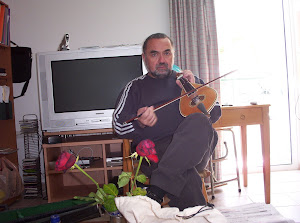Japanese noh play, Shakkyo (Stone bridge). It's in two parts, one and two
Here is the summary
Shakkyō is a kirinoh, or the last piece performed in the entire Noh program. This piece describes auspiciousness and includes a unique Shishimai, or lion dance. The lion dance is considered an advanced skill which requires special forms, movements, and expressiveness. Therefore Shakkyō is classified into one of the hiraki-mono. Hiraki-mono is a kind of an initiation ceremony in the Noh world, which demonstrates that the performer has reached a specific level of learning in his or her Noh training. Parts of staging differ by schools; while the other schools position the boy as mae-shite (the first half lead part) while the Hosho school positions him as tsure (the companion of shite). Also, the Hosho school omits ai-kyogen (interlude). Under modern theatrical circumstances it often happens that only the second half of this piece is performed (han-noh). Renjishi or the lion dance by two lions is also a popular way of staging in many schools.
Here is the summary
STORY PAPER
: Shakkyō (Stone Bridge)
Shakkyō
Shakkyō
Monk Jakushō (also known as Ōe no Sadamoto before he renounced the world)
is traveling around China and India visiting the places associated with Buddha.
One day he arrives at a stone bridge in Mount Shōryōzen in China (located in
the present Shanxi Province). A woodcutter boy appears. The boy exchanges words
with Jakushō and tells him that the land beyond the bridge is the Pure Land
belonging to Monju Bosatsu (Manjusri Bodhisattva) and that crossing this long,
narrow bridge arching over a deep gorge is not easy for humans (indicating the
difficulty of Buddhist ascetic training). The boy predicts that the monk will
see a miracle if he stays at the bridge, and then he disappears.
From the other side of the bridge there comes to the waiting Jakushō, a
lion (or lions), messenger of Manjusri Bodhisattva. The lion plays with
gorgeous, fragrant peony flowers. After dancing a lion dance, the lion returns
to his designated position, which is the carrier of Manjusri Bodhisattva.
Shakkyō is a kirinoh, or the last piece performed in the entire Noh program. This piece describes auspiciousness and includes a unique Shishimai, or lion dance. The lion dance is considered an advanced skill which requires special forms, movements, and expressiveness. Therefore Shakkyō is classified into one of the hiraki-mono. Hiraki-mono is a kind of an initiation ceremony in the Noh world, which demonstrates that the performer has reached a specific level of learning in his or her Noh training. Parts of staging differ by schools; while the other schools position the boy as mae-shite (the first half lead part) while the Hosho school positions him as tsure (the companion of shite). Also, the Hosho school omits ai-kyogen (interlude). Under modern theatrical circumstances it often happens that only the second half of this piece is performed (han-noh). Renjishi or the lion dance by two lions is also a popular way of staging in many schools.
The highlight of this piece is the extraordinary gorgeousness of the dance.
It will fill the audience with brightness and briskness. Since even novices to
the Noh art can straightforwardly enjoy this piece, it was performed to
entertain distinguished guests from overseas.








No comments:
Post a Comment